Home > Differences in Various S/I Systems[DC, AC, Pulse DC, Pulse AC, High frequency, Plasma and Plasma DC Pulse systems]
Differences in Various S/I Systems
A static ionizer is available in various systems in a principle and structure and each has own merits and demerits. In the real world, however, there are ones in question for the effectiveness, having a reverse effect, vulnerable components, troublesome in maintenance, a possibility to breakdown semiconductors, a fire and electric shock risk, or needing to pay attention for the use. Here we sum up their main merits and demerits in the hope of these contributing to your reference in the study.
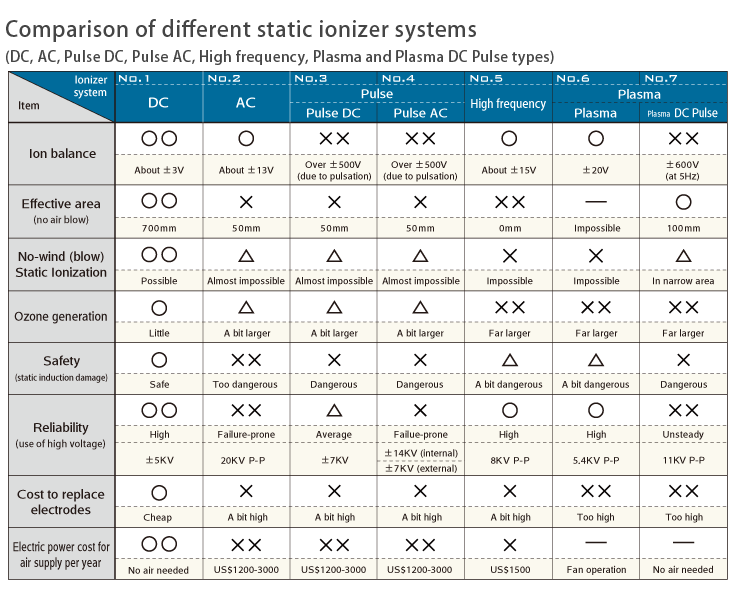


| 1. |
Ion balance is well kept within ±3V. |
| 2. |
No pulsation in ion balance makes static ionizer used safely. |
| 3. |
Ion balance varies from place to place over the length of bar. It tends to differ depending on the system application. |
| 4. |
No ion balance pulsation occures if an object comes closer to ionizer even up to 100mm, so no affection is expected to electronic circuits and diordes. |
| 5. |
"No-wind ionization®" possible. A wide ionizing area with 700mm (longitudinal) enables no air blow operation. |
| 6. |
No-wind ionization® promises no dust-related defect, as it does not use fan to cause an electric leak or to raise dust. |
|
 |

| 1. |
The attained ion balance is medium with around ±13V, which is harmful to vulnerable electronic components. |
| 2. |
The ion balance pulsates at 50/60Hz, giving about ±7V even at 300mm away. Harmful to vulnerable diodes and LCD. |
| 3. |
Too dangerous to move diodes and LCD closer to the ststic ionizer. A pulsation of ion balance and electric field around needle can destroy them if they are brought within a range of 100mm. |
| 4. |
"No-wind (blow) ionization" is not possible, because its effective ionizing area is as small as about 50mm. |
| 5. |
To cover the loss, a compressed air or a fan is used, which in turn could cause a electric leak and dust related defects. |
|
 |

| 1. |
The attained ion balance is so poor as to go up to even over ±500V. |
| 2. |
The ion balance pulsates tuned to a pulse frequency, even up to ±500V at 300mm away (at no air blow, 1-40Hz) |
| 3. |
Too dangerous to bring diodes and LCD closer to the static ionizer. A pulsation of ion balance and electric field around needles can destroy them if they are brought within a range of 300mm. |
| 4. |
"No-wind (blow) ionization" is not possible, because its effective ionizing area is as small as about 50mm. |
| 5. |
To cover the loss, a compressed air or fan is used, which in turn causes a electric leak and dust related defects. |
|
 |

| 1. |
The attained ion balance is so poor as to go up to even over ±500V. |
| 2. |
The ion balance pulsates tuned to a pulse frequency, even up to ±500V at 300mm away (at no air blow, 1-40Hz) |
| 3. |
Too dangerous to bring diodes and LCD closer to the static ionizer. A pulsation of ion balance and electric field around needles can destroy them if they are brought within a range of 300mm. |
| 4. |
"No-wind (blow) ionization" is not possible, because its effective ionizing area is as small as about 50mm. |
| 5. |
To cover the loss, a compressed air or fan is used, which in turn causes a electric leak and dust related defects. |
|
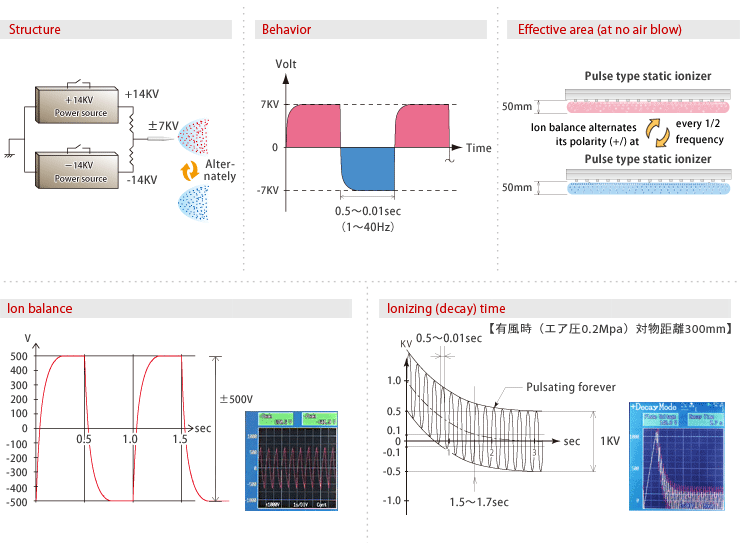 |

| 1. |
The attained ion balance is so poor as to go up to even over ±500V. |
| 2. |
Easy to downsize. |
| 3. |
"No-wind (air blow) ionization" is not possible, as ions are not emanated without a help of compressed air or fan. |
| 4. |
A lot of ozone is produced, so any of rubber-made products should not be placed inside the area to avoid deterioration. |
|
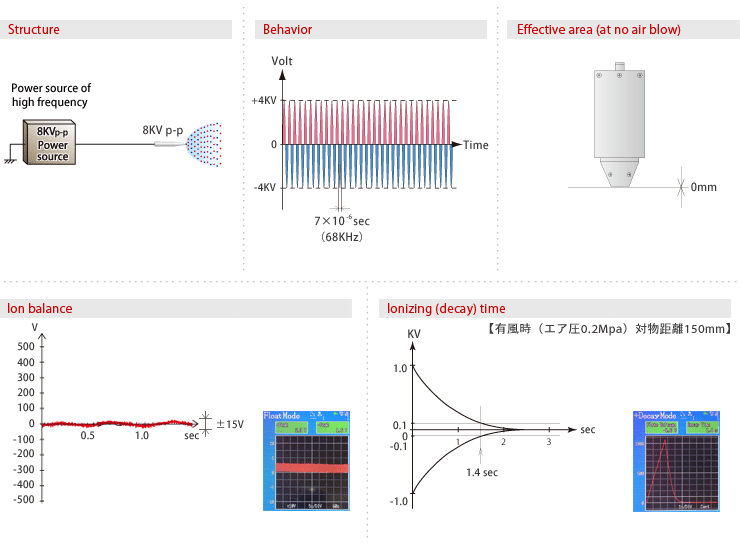 |

| 1. |
The device uses a platy electrode instead of normal needle type electrodes. |
| 2. |
Simple cleaning of the pate makes a maintenance relatively easier. |
| 3. |
The platy electrode has a short service life. |
| 4. |
Platy electrode costs very high (20 times the cost of conventional needle type electrode). |
| 5. |
The device cannot be operated without air blow. |
| 6. |
The device may stop emitting ions or become unsteady depending on humidity changes. |
| 7. |
Ozone generation is so intense that workers may upset. There is a possibility of their throat and lung being ruined. |
| 8. |
The ozone generated may rust surrounding metal parts. |
| 9. |
The ozone generated may deteriorate sealing materials, like the oil seal, and rubber parts, like the packing and electric cord, to make them torn to shreds. |
|
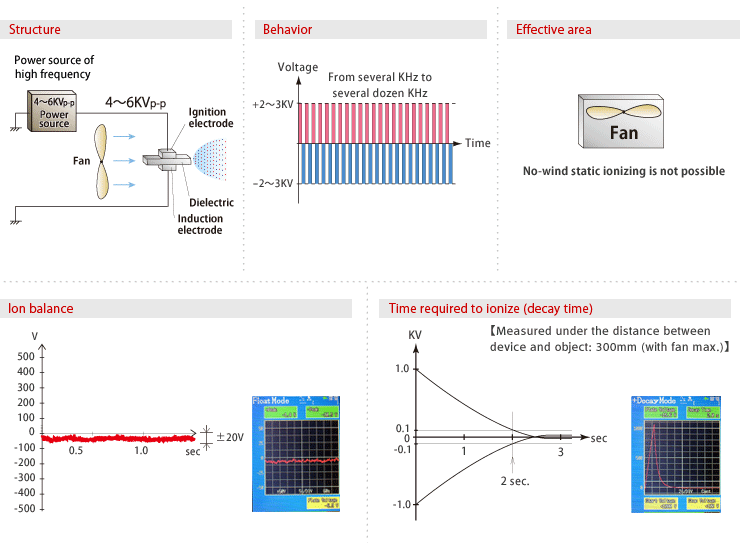 |

| 1. |
The device uses a platy electrode instead of normal needle type electrodes. |
| 2. |
Simply cleaning the pale makes a maintenance relatively easier. |
| 3. |
The platy electrode has a short service life. |
| 4. |
Platy electrode costs very high (20 times the cost of conventional needle type electrode). |
| 5. |
Ion balance is so bad that it may create a dangerous situation (Voltage goes up to ±600V at 5Hz) |
| 6. |
Effective static eliminating distance is so short as to fall in 50 to 100mm. |
| 7. |
The device may stop emitting ions or become unsteady depending on humidity changes. |
| 8. |
Ozone generation is so intense that workers may upset. There is a possibility of their throat and lung being ruined. |
| 9. |
The ozone generated may rust surrounding metal parts. |
| 10. |
The ozone generated may deteriorate sealing materials, like the oil seal, and rubber parts, like the packing and electric cord, to make them torn to shreds. |
|
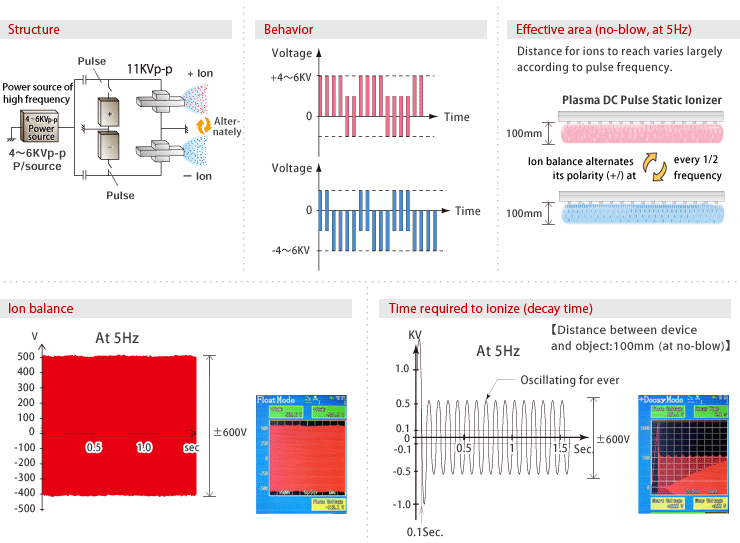 |
TRINC corporation
【Head Office】748-37 Okubo-cho, Chuo-ku, Hamamatsu-City, Shizuoka-Pref. 432-8006 Japan Tel: +81-53-482-3412 Fax: +81-53-482-3414
【TRINC Laboratory and Demo Center】719-1 Kamihara-cho, Chuo-ku, Hamamatsu-city Shizuoka-pref. 432-8007 Japan Tel: +81-53-401-1088
【Shanghai office】Room No.1113, 525 Cheng Yin Road, Bao Shan District, Shang Hai City, CHINA 200444
Copyright (c) TRINC CORPORATION. All rights reserved.








